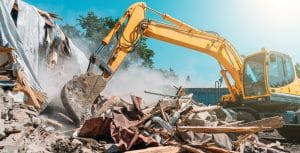A Section 80 Demolition Notice is a key legal measure in the United Kingdom, intended to ensure that demolition work proceeds with safety and compliance in mind. Before you bring down any major structure, you must notify the local authority and confirm that you have met all relevant standards. This measure also helps protect the public and environment from potential risks linked to demolition activities, such as debris, dust, or unexpected structural failures.
In essence, the Section 80 Demolition Notice process makes certain that your plan to tear down a building does not place workers, neighbours, or road users in harm’s way. Authorities require insight into the scope of your project so they can respond to potential hazards and, if necessary, impose rules that keep everything under control. Bath Demolition doesn’t just offer Demolition services, we can guide you through this process, ensuring your demolition unfolds smoothly from initial paperwork to final clearance. In this comprehensive explanation, we will look at what Section 80 means, how to apply for it, and the consequences of failing to comply.
This page also clarifies how planning permission for demolition can intersect with Section 80 requirements, while providing information on associated regulations.
What is a Section 80 Demolition Notice?
The Section 80 Demolition Notice originates from the Building Act 1984, which regulates various activities linked to construction and demolition. Submitting such a notice is mandatory if your demolition project meets certain thresholds regarding size, scope, or building type. The primary intent is to inform the local authority about your planned work. This allows them to monitor the process and ensure important factors such as public safety, waste management, and structural stability are addressed.
When you give proper notice, local building control offices gain the chance to review your methods for dismantling the structure. They may also look into any special site conditions, such as the presence of hazardous materials. By following this procedure, you set the stage for a well-organised demolition that does not endanger workers or passersby. Equally, the notice makes it simpler to comply with health and safety regulations, since local authorities often outline best practices or demand certain preventive actions before issuing approval.
Some property owners confuse the Section 80 Demolition Notice with planning permission for demolition, assuming that obtaining one is equivalent to having the other. In reality, these are two distinct processes. Planning permission focuses on development control and zoning matters, whereas Section 80 targets safe practices and thorough regulation of demolition work. A project might require one, both, or neither, depending on factors like local planning policy and the building’s heritage status.
When is a Section 80 Demolition Notice Required?
Section 80 is generally required when you plan to demolish an entire building or a substantial part of a structure. In most councils across England and Wales, there is a specific floor area or scale threshold. If the building meets or surpasses that threshold, you must issue a demolition notice. Even if your structure appears small, it is wise to contact the local authority if you have any doubt, since regulations can differ from one location to another.
There are exceptions to this rule. Small sheds, temporary shelters, or modest outbuildings might not trigger the requirement, depending on their dimensions. Some local authorities provide a straightforward guide on which types of structures qualify. However, the best practice is to check official advice or engage a contractor with experience in demolition regulations. If you simply knock down a structure without filing the Section 80 notice, you risk facing unexpected delays and enforcement measures later. A swift inquiry early in your planning stage can save you from major complications down the line.
Furthermore, certain areas have heritage or conservation constraints. If your property lies in a sensitive zone or is a listed building, you may need other approvals or consents. In those circumstances, ignoring the official route can result in legal action or fines. By contrast, following every procedural step ensures a smoother path to completing your demolition tasks without incurring penalties or local authority objections.
How to Apply for a Section 80 Demolition Notice
Acquiring a Section 80 Demolition Notice is a clear, step-by-step process, although the details can differ slightly from one local council to another. Below is a concise guide on how to apply:
- Identify Your Local Authority
Locate the building control division for your region. Their website often includes guidelines for demolition and a specific form you must fill in. If no form is listed, you can phone or email them to request further information. - Gather Essential Details
Collect accurate data related to your demolition project. You should know the site address, an estimated schedule, and the structural features of the building. It is also important to identify any materials that pose a risk, like asbestos. - Complete the Official Form
Fill in the application with your personal information, the project’s address, and a full description of your planned demolition methods. Provide a realistic timeline and details on how you intend to mitigate hazards like dust, noise, or waste disposal. - Attach Supporting Documents
Include plans or diagrams of the site, along with any engineering reports or risk assessments that support your approach. If you have obtained planning permission for demolition, it is helpful to add documentation showing that approval. - Submit Your Application
Send your package to the council’s building control department, either by post or through any online submission system they provide. Some local authorities charge a fee, so check their payment instructions in advance. - Await Feedback
After you submit, the local authority will review your request. They might ask for extra details or clarifications. Once they are satisfied, they will either give you permission to proceed or attach specific conditions to your notice.
Bath Demolition offers help at each stage of this process, including liaising with building control and organising all necessary documents. This assistance ensures your demolition notice requirements are met without unnecessary stress or confusion.
What Happens After Submitting a Section 80 Notice?
Once your application is lodged, the local authority examines its content to see whether your plan aligns with UK demolition regulations. They may visit the site to check potential safety issues, discuss scheduling, and confirm the overall scope. If your demolition involves flammable substances, structural instability, or other hazards, officials will want to know how you plan to handle such risks.
If the authority agrees with your approach, you will likely receive a formal notice that allows you to begin. This approval could include conditions related to waste segregation, noise control, or site security. Should the council spot any deficiencies, they could instruct you to revise or resubmit parts of your plan. In some cases, they could serve a notice forbidding you to start until certain concerns are resolved.
It is important to remember that you usually must wait for a set period—often 6 weeks—before demolition can start. This interval gives the council enough time to notify essential parties like utility providers or emergency services. Skipping or shortening this period might lead to non-compliance, which can cause legal issues or penalties if the council believes you have not followed the correct procedure.

Planning Permission and Other Legal Considerations
Planning permission for demolition is related but separate from Section 80 in most parts of the UK. While Section 80 focuses on safe methods and oversight, planning permission deals with zoning and the broader community impact. In many cases, straightforward demolitions do not need formal planning consent if the building is not listed or in a conservation area. However, if your site is of historical value or if you aim to build something new in its place, planning permission might become mandatory.
You also need to pay attention to health and safety regulations, including the Construction (Design and Management) Regulations. These rules state that you must safeguard workers, visitors, and anyone passing near the site from potential risks. You need measures for handling hazardous materials like asbestos, as well as strategies for controlling debris and dust. At Bath Demolition, we offer services that address both the official and practical side of demolition. By doing so, we help clients avoid time-consuming disputes and keep all stages of their projects on track.
Apart from planning and health considerations, you may face environmental obligations. Noise, vibration, and air quality can all affect local residents. If the authority believes your project will generate significant disturbance, they might impose conditions such as restricted working hours or requirements for dampening dust. Meanwhile, if you uncover protected species on-site, you must consult specialised experts to avoid breaking wildlife protection laws. These additional steps can sometimes prolong your overall schedule, but they are necessary to ensure full compliance and responsible demolition.
Penalties for Not Complying with Section 80 Requirements
Failing to meet the Section 80 demolition notice requirements can have serious repercussions. Councils have the power to issue stop notices that prevent any further work until legal steps are taken. They can also levy fines or pursue court action if they believe there has been a wilful breach of regulations. Besides direct penalties, you might encounter delayed timelines or higher project costs if you have to redo plans or pay legal fees.
Non-compliance undermines the objective of keeping demolition work safe and well-regulated. If you proceed with demolition in secret or ignore official instructions, you could create risks for workers, neighbours, and local infrastructure. Rather than inviting these complications, it is far better to follow the correct path from the start. Submitting accurate paperwork and maintaining clear communication with the council helps you sidestep unnecessary hurdles.
Frequently Asked Questions About Section 80 Demolition Notice
Is a Section 80 Demolition Notice similar to planning permission for demolition?
They are separate legal processes. Section 80 addresses demolition safety and site control, while planning permission deals with whether the demolition fits with local development policies. Depending on local rules, you could need one, both, or neither.
Who is responsible for filing the demolition notice?
The property owner or the party carrying out the demolition must file. Contractors can handle the application on their client’s behalf, but it remains the owner’s duty to ensure the process is completed correctly.
Do I always need a risk assessment?
It is strongly recommended to have a formal risk assessment, especially if you suspect hazardous materials or structural weaknesses. This assessment helps the local authority confirm that you are prepared to handle dangers responsibly.
How long must I wait after sending in my demolition notice?
You usually need to wait for a specified period—often up to 6 weeks—so the council can review and respond to your application. Jumping the gun could lead to legal problems and a possible halt to your project.
Can I start demolition if I have planning permission but no Section 80 notice?
No. Even if you have planning permission, you still need to file a Section 80 Demolition Notice if the building meets the criteria. These are two distinct steps that serve different purposes.
Conclusion
A Section 80 Demolition Notice ensures that both the local authority and demolition teams have a shared understanding of any planned structure removal. It informs officials about the scope of the work, fosters compliance with building control demolition standards, and helps prevent dangers or disruptions. While planning permission for demolition can sometimes overlap, it remains a separate consideration, aimed at matters like development control and aesthetic concerns.
By committing to the Section 80 process, you protect workers, neighbours, and public property from harm, and you align your project with all relevant regulations. Although the procedure can seem complex at first, it becomes far less intimidating when broken down into clear steps. Bath Demolition supports property owners in every stage, from explaining demolition notice requirements and building control steps, to overseeing on-site safety. If you wish to avoid costly setbacks or fines, it pays to approach demolition with the right knowledge and professional guidance.
In following these best practices, you help create a well-managed demolition project that respects local laws and community standards. This approach allows you to complete your work on schedule, minimise hazards, and proceed with confidence, knowing you are acting in line with UK guidelines. By remaining transparent and cooperative with the local authority, you pave the way for a smooth, swift demolition that meets everyone’s needs.










